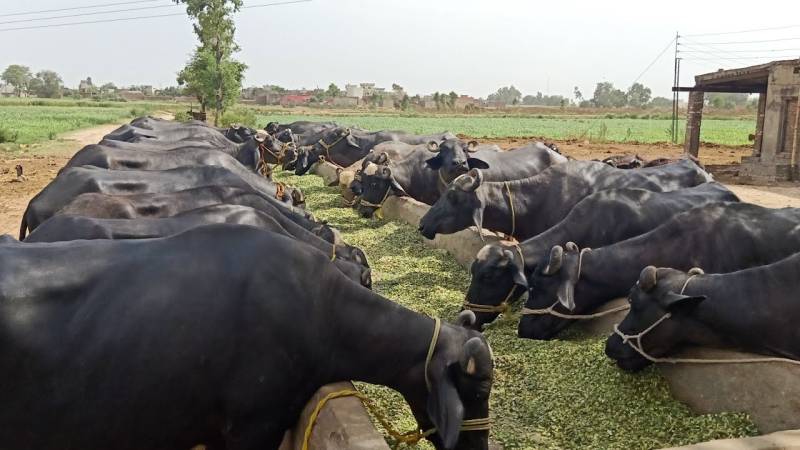
Pakistan is a growing economy, and the agriculture sector continues to be the largest sector. This gives it a dominant position as a driving force for economic growth. The vast majority of the rural population depends on agricultural activity as their main source of income, along with ensuring availability of food for the country’s burgeoning population. Agriculture also provides inputs to other sectors of the economy – such as textile, sugar, leather, and feed mills, as these sectors receive raw materials from agricultural produce, and have a major contribution in the export earnings of the country.
According to the Small and Medium Enterprises Development Authority’s (SMEDA) sector brief report ‘Dairy and Livestock Sector of Pakistan’, the livestock sector is contributing 60% to 70% to value added agriculture and 11.53% to Gross Domestic Product (GDP). It is relatively less inconsistent, as compared to other subsectors in agriculture. This sector does not depend on methods involving heavy machinery and capital goods, energy and other developed infrastructure. Being labor intensive, livestock rearing can be performed by households, which contributes to the socioeconomic well-being of the rural human landscape. Livestock’s share in agriculture is more than combined shares of cotton and wheat. Older methods are being utilized by the livestock farmers to great effect, however, there is still space for more innovation.
The sector has registered an increasing growth rate of 3.06% in year 2020-21 against 2.10% during the previous year. More than 8 million rural families are engaged in livestock production and derive more than 35-40% of their income from this source. Gross value addition of livestock at constant cost factor of 2005- 06 has increased to Rs. 1,505 billion (2020-21) from Rs. 1,461 billion (2019-20), an increase of 3 % over the same period last year. This demonstrates amazing growing on the business line during recent times.
In fact, Pakistan ranks among the top five milk producing countries globally. The dairy and livestock sector comprise of around 80 million cows and buffaloes, and 100 million sheep and goats in numbers; producing more than 60 million tons of milk besides producing other products including meat, and skins. Within the livestock sector, milk is the most important commodity with demand growing at 10-15% annually, yet production increases by only 3–4% annually.
Due to the milk supply gap of 3.5 billion liters in 2020-21, value added products such as cheese, butter and powdered milk are imported to meet rapidly rising domestic demand.
How shall the milk supply gap be bridged is a big question for policymakers in Pakistan.
The need is therefore to give the livestock sector space on the development agenda, conceiving a top-down framework to meet the demand and supply gap, aimed at strengthening GDP of Pakistan and contributing to socioeconomic development and growth.
Challenges in the dairy Sector
Being one of the top milk producing countries, Pakistan lacks the capability to utilize resources efficiently for increased productivity. One problem is that policy is focused around incentivizing imports rather than exporting livestock products to international consumers. The reasons behind this prevailing gap are immense efficiency losses in production, the lack of awareness in farmer and producer communities for methods on increasing milk output, integration within the dairy value and supply chain, policy issues and resource restraints to implement initiatives at a macro level in Pakistan.
The current situation of the dairy sector is such that it can’t be expected to meet existing and expected domestic demand unless major reforms are introduced within the sector. Conventional milk production, collection and distribution do not meet quality and hygiene standards, which are further exacerbated by inappropriate facilities of storage and transportation and impurity of milk.
The major limitations of the livestock sector include, but are not limited to: limited outreach of public sector initiatives to distant locations, limited awareness about farm productivity, milk safety, and quality issues and standards for milk production, handling and processing/value addition of milk and lack of awareness of Pre-Requisite Programs (PRPs) such as Good Husbandry Practices, Good Manufacturing Practices, and Good Hygienic Practices as per minimum standards set by Codex Alimentarius.
Therefore, low milk output per animal on farm level persists due to conventional animal husbandry practices and poor farm management resulting in inadequate feeding, poor breeding and Artificial Insemination cover, insufficient disease cover, failure to control mastitis, limited implementation and adherence to standard food safety management systems and regulations in milk production.
The lack of knowledge and training of skilled and semi-skilled workers on food safety standards for value addition of milk through churning (butter, butter milk fat products, ice cream etc.), evaporation (dry or condensed milk), pasteurization and UHT (fermented products, yogurt, buttermilk, cheese, sour cream) and homogenization (skimmed milk, fortified milk, flavored milk, whipped cream etc.) and an absence of proper pricing structure as the farm gate price of milk varies with seasons in the traditional marketing systems, combines with widespread lack of knowledge for packaging and branding to make products distinct from others and fetch premium prices due to their likeness by consumers to keep production levels and profits low. These problems are compounded by a lack of knowledge regarding the potential of export markets.
These issues make it difficult to achieve desirable growth and trade targets, unless targeted policy interventions and measures are taken to improve the sector’s overall performance and growth. There are numerous opportunities available in the sector to integrate and produce high value-added products that can not only cater to domestic demand of a large customer base but may also provide openings for exporting them to the international markets where food security is a rising concern.
According to the Small and Medium Enterprises Development Authority’s (SMEDA) sector brief report ‘Dairy and Livestock Sector of Pakistan’, the livestock sector is contributing 60% to 70% to value added agriculture and 11.53% to Gross Domestic Product (GDP). It is relatively less inconsistent, as compared to other subsectors in agriculture. This sector does not depend on methods involving heavy machinery and capital goods, energy and other developed infrastructure. Being labor intensive, livestock rearing can be performed by households, which contributes to the socioeconomic well-being of the rural human landscape. Livestock’s share in agriculture is more than combined shares of cotton and wheat. Older methods are being utilized by the livestock farmers to great effect, however, there is still space for more innovation.
The sector has registered an increasing growth rate of 3.06% in year 2020-21 against 2.10% during the previous year. More than 8 million rural families are engaged in livestock production and derive more than 35-40% of their income from this source. Gross value addition of livestock at constant cost factor of 2005- 06 has increased to Rs. 1,505 billion (2020-21) from Rs. 1,461 billion (2019-20), an increase of 3 % over the same period last year. This demonstrates amazing growing on the business line during recent times.
In fact, Pakistan ranks among the top five milk producing countries globally. The dairy and livestock sector comprise of around 80 million cows and buffaloes, and 100 million sheep and goats in numbers; producing more than 60 million tons of milk besides producing other products including meat, and skins. Within the livestock sector, milk is the most important commodity with demand growing at 10-15% annually, yet production increases by only 3–4% annually.
Due to the milk supply gap of 3.5 billion liters in 2020-21, value added products such as cheese, butter and powdered milk are imported to meet rapidly rising domestic demand.
How shall the milk supply gap be bridged is a big question for policymakers in Pakistan.
The need is therefore to give the livestock sector space on the development agenda, conceiving a top-down framework to meet the demand and supply gap, aimed at strengthening GDP of Pakistan and contributing to socioeconomic development and growth.
Challenges in the dairy Sector
Being one of the top milk producing countries, Pakistan lacks the capability to utilize resources efficiently for increased productivity. One problem is that policy is focused around incentivizing imports rather than exporting livestock products to international consumers. The reasons behind this prevailing gap are immense efficiency losses in production, the lack of awareness in farmer and producer communities for methods on increasing milk output, integration within the dairy value and supply chain, policy issues and resource restraints to implement initiatives at a macro level in Pakistan.
The current situation of the dairy sector is such that it can’t be expected to meet existing and expected domestic demand unless major reforms are introduced within the sector. Conventional milk production, collection and distribution do not meet quality and hygiene standards, which are further exacerbated by inappropriate facilities of storage and transportation and impurity of milk.
The major limitations of the livestock sector include, but are not limited to: limited outreach of public sector initiatives to distant locations, limited awareness about farm productivity, milk safety, and quality issues and standards for milk production, handling and processing/value addition of milk and lack of awareness of Pre-Requisite Programs (PRPs) such as Good Husbandry Practices, Good Manufacturing Practices, and Good Hygienic Practices as per minimum standards set by Codex Alimentarius.
Therefore, low milk output per animal on farm level persists due to conventional animal husbandry practices and poor farm management resulting in inadequate feeding, poor breeding and Artificial Insemination cover, insufficient disease cover, failure to control mastitis, limited implementation and adherence to standard food safety management systems and regulations in milk production.
The lack of knowledge and training of skilled and semi-skilled workers on food safety standards for value addition of milk through churning (butter, butter milk fat products, ice cream etc.), evaporation (dry or condensed milk), pasteurization and UHT (fermented products, yogurt, buttermilk, cheese, sour cream) and homogenization (skimmed milk, fortified milk, flavored milk, whipped cream etc.) and an absence of proper pricing structure as the farm gate price of milk varies with seasons in the traditional marketing systems, combines with widespread lack of knowledge for packaging and branding to make products distinct from others and fetch premium prices due to their likeness by consumers to keep production levels and profits low. These problems are compounded by a lack of knowledge regarding the potential of export markets.
These issues make it difficult to achieve desirable growth and trade targets, unless targeted policy interventions and measures are taken to improve the sector’s overall performance and growth. There are numerous opportunities available in the sector to integrate and produce high value-added products that can not only cater to domestic demand of a large customer base but may also provide openings for exporting them to the international markets where food security is a rising concern.

